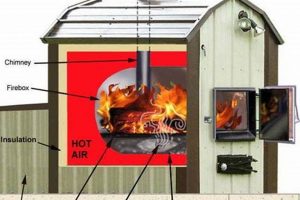Construction of a self-assembled structure designed for storing combustible fuel, specifically wood, in an exterior environment is the subject of this discussion. Such constructions serve to elevate wood off the ground, promoting air circulation and preventing moisture absorption, which contributes to its longevity and combustibility. An example would be a frame built from repurposed metal pipes or lumber, intended to hold firewood stacks within a backyard or against an external wall of a dwelling.
The practice of elevating firewood storage is critical for several reasons. Reduced ground contact minimizes the risk of rot and insect infestation, both of which degrade wood quality. Improved air circulation accelerates the drying process, seasoning the wood for more efficient burning, which in turn reduces smoke and increases heat output. Historically, woodpiles were simply placed directly on the ground, leading to significant waste and inefficiency. Modern approaches, including self-constructed solutions, address these issues, providing a more sustainable and cost-effective method for storing fuel.
The following sections will explore design considerations, material selection, and step-by-step construction techniques relevant to creating an effective outdoor wood storage solution. Furthermore, various aesthetic and functional variations will be discussed, along with tips for maintaining the structural integrity of the finished product.
Tips for Optimizing Outdoor Firewood Storage Structures
This section offers practical guidance for designing and building an efficient and durable structure for storing combustible fuel outdoors. These recommendations emphasize functionality, longevity, and safety.
Tip 1: Site Selection is Paramount. The chosen location should be elevated or well-drained to minimize ground contact with the firewood. A site with southern exposure maximizes sunlight exposure, accelerating the drying process. Furthermore, ensure adequate clearance from structures and vegetation to mitigate fire hazards.
Tip 2: Prioritize Material Durability. Select materials resistant to rot, insect infestation, and weather exposure. Treated lumber, naturally durable wood species like cedar or redwood, or powder-coated metal are recommended. Untreated wood will require regular maintenance and may have a shorter lifespan.
Tip 3: Incorporate Adequate Airflow. Design the structure to allow for optimal air circulation around the firewood. This promotes drying and prevents the buildup of moisture, which can lead to rot. Leave gaps between wood stacks and ensure the base is elevated.
Tip 4: Ensure Structural Stability. The structure must be capable of withstanding the weight of the firewood, as well as wind and snow loads. Use appropriate fasteners and construction techniques to ensure stability. Consider incorporating bracing or anchoring systems for added support.
Tip 5: Implement a Weather Protection Strategy. While maximizing airflow is crucial, some degree of weather protection is also beneficial. A roof or overhang can shield the firewood from rain and snow, further reducing moisture absorption. Ensure the design allows for sufficient ventilation beneath the roof to prevent condensation.
Tip 6: Adhere to Safety Regulations. Consult local building codes and fire safety regulations before construction. Ensure the structure is located at a safe distance from property lines and combustible materials. Maintain a clear firebreak around the perimeter of the structure.
Tip 7: Proper stacking of wood will allow more air flow. Stacking wood parallel to each other with some air gaps is important. Never compact wood for the sake of fitting it all in.
By adhering to these guidelines, individuals can construct an effective and durable structure for storing fuel in an outdoor environment, ensuring its longevity and combustibility while minimizing safety risks.
The following section will address common construction errors to avoid when building an outdoor structure for storing fuel. This aims to provide further insight and clarity before embarking on the project.
1. Elevation
Elevation is a foundational element in the construction of a self-assembled outdoor wood storage structure. Its primary function is to physically separate the stored fuel from the ground, mitigating moisture absorption and fostering optimal air circulation.
- Prevention of Moisture Wicking
Direct contact with the ground allows moisture to wick into the firewood, promoting rot and fungal growth, thus diminishing its combustibility. Elevating the structure, even by a few inches, creates a barrier against this moisture transfer. Examples include using cinder blocks, pressure-treated lumber supports, or even repurposed pallets as a base for the structure. Without elevation, the lower layers of wood are susceptible to rapid degradation.
- Enhanced Airflow Underneath
Elevation facilitates airflow beneath the stack, promoting drying and reducing the likelihood of mold and mildew formation. Air circulation removes moisture released from the wood, further accelerating the seasoning process. A simple framework of spaced lumber can provide sufficient elevation and ventilation. Insufficient elevation impedes airflow, prolonging drying times and potentially leading to spoilage.
- Pest Deterrence
Elevating the wood can deter ground-dwelling pests, such as insects and rodents, from infesting the pile. While it may not completely eliminate the risk, it makes the wood less accessible and attractive. Raising the rack makes it easier to inspect for and manage any pest presence. Without elevation, the firewood becomes a more accessible habitat for various pests.
- Minimizes Debris Accumulation
Elevation helps to keep the firewood clear of ground-level debris such as leaves, dirt, and snow. This reduces the amount of foreign material that can contaminate the wood and potentially interfere with its burning efficiency. An elevated rack allows for easier sweeping or clearing of the area around the woodpile. Without elevation, the firewood is more prone to accumulating debris, requiring more frequent cleaning and maintenance.
In conclusion, the incorporation of elevation into a self-constructed outdoor wood storage solution is not merely an aesthetic choice but a practical necessity. It safeguards the fuel from moisture, enhances drying efficiency, deters pests, and minimizes debris accumulation, thereby extending the life and usability of the stored wood. The extent of elevation required will vary depending on climate and ground conditions, but even a minimal increase in height can significantly improve the overall effectiveness of the storage solution.
2. Ventilation
Effective ventilation is a critical design parameter for any self-constructed outdoor wood storage structure. Its influence on the quality and longevity of the stored fuel is paramount, dictating the rate of drying, the prevention of decay, and the overall suitability of the wood for combustion.
- Moisture Reduction and Seasoning
The primary role of ventilation is to facilitate the removal of moisture from the wood. Green or freshly cut wood contains a significant amount of water, which must be evaporated before the wood can burn efficiently. Adequate airflow accelerates this seasoning process, reducing the moisture content to an optimal level (typically below 20%). Without proper ventilation, the drying process is significantly prolonged, leading to inefficient burning and increased smoke production. The design of the structure should incorporate gaps between wood stacks and an open structure to maximize air exposure.
- Prevention of Fungal Growth and Decay
High moisture levels create an environment conducive to fungal growth and decay. Wood-rotting fungi thrive in damp conditions and can rapidly degrade the structural integrity and energy content of the wood. Ventilation helps to maintain a drier environment, inhibiting fungal growth and prolonging the lifespan of the fuel. The free flow of air discourages the establishment of moisture pockets, preventing localized decay. Proper spacing between the wood pieces also minimizes fungal spread due to air exposure.
- Minimizing Insect Infestation
While not a direct deterrent, adequate ventilation can indirectly reduce the risk of insect infestation. Many wood-boring insects prefer damp, dark environments. By promoting dryness and air circulation, the structure becomes less attractive to these pests. Regular inspection for signs of infestation is still necessary, but proper ventilation can contribute to a less hospitable environment for wood-damaging insects. Removing loose bark from wood can improve ventilation and deter insects.
- Structural Integrity Preservation
Ventilation also indirectly contributes to the preservation of the structural materials of the wood storage unit itself. By preventing moisture buildup within the structure, ventilation reduces the risk of rot and corrosion, extending the lifespan of the wood or metal components used in its construction. The open design of a well-ventilated structure allows for easier inspection and maintenance, facilitating the early detection and correction of any structural issues.
In conclusion, the incorporation of effective ventilation into a self-assembled outdoor wood storage solution is not merely a secondary consideration but a fundamental requirement. It ensures the efficient seasoning of the wood, prevents decay and fungal growth, minimizes the risk of insect infestation, and contributes to the overall longevity of both the fuel and the storage structure itself. The design should prioritize airflow, with open sides and elevated bases, to maximize the benefits of ventilation.
3. Material Durability
The longevity and functionality of a self-constructed outdoor wood storage structure are directly contingent upon the durability of the materials used in its construction. The external environment presents a range of challenges, including exposure to precipitation, temperature fluctuations, ultraviolet radiation, and potential pest infestations. Consequently, material selection is paramount in ensuring the structure’s ability to withstand these elements and effectively protect the stored fuel. The use of inappropriate materials will inevitably lead to premature degradation, compromising the structural integrity of the rack and exposing the wood to the elements it is intended to shield against. For example, untreated softwood exposed to constant moisture will quickly succumb to rot, rendering the entire structure unstable. This, in turn, defeats the purpose of the storage solution.
Durable materials appropriate for outdoor wood storage construction include pressure-treated lumber, naturally decay-resistant wood species like cedar or redwood, and certain metals such as powder-coated steel or aluminum. Pressure-treated lumber undergoes a chemical process that renders it resistant to rot and insect damage, significantly extending its lifespan in outdoor applications. Similarly, cedar and redwood contain natural oils that inhibit decay. Metal frames offer inherent strength and resistance to physical damage, but require appropriate coatings to prevent rust. The selection of materials should also consider the local climate and the potential for extreme weather events. In regions with heavy snowfall, for example, a robust frame constructed from durable materials is essential to prevent collapse under the weight of accumulated snow. In coastal areas, materials resistant to salt corrosion are a necessity.
Ultimately, the investment in durable materials for a self-constructed outdoor wood storage structure is a long-term investment in the preservation of both the rack and the firewood it protects. While cost considerations are a factor, prioritizing durability will minimize the need for frequent repairs or replacements, resulting in a more sustainable and cost-effective solution over time. The understanding of material properties and their suitability for outdoor applications is therefore crucial for the successful design and construction of a functional and long-lasting wood storage structure.
4. Structural Integrity
Structural integrity is a non-negotiable attribute of any self-assembled outdoor firewood rack. The cause-and-effect relationship is straightforward: inadequate structural design or execution results in rack failure, leading to scattered firewood, potential injury, and the loss of stored fuel. A firewood rack inherently bears significant weight, often exceeding several hundred pounds. Moreover, it is subject to environmental stresses such as wind, snow loads, and ground settling. The rack’s ability to withstand these forces without collapsing defines its structural integrity.
The importance of structural integrity manifests in several practical ways. A well-built rack maintains its form, ensuring consistent and accessible storage. For example, a frame constructed with properly sized lumber, securely fastened joints, and a stable base will resist leaning or buckling, even under heavy loads. Conversely, a poorly constructed rack, using undersized materials or inadequate fastening methods, will likely deform over time, potentially collapsing and creating a safety hazard. Consider the ramifications of a snow-laden rack collapsing during winter; not only does it compromise the fuel supply, but it also presents a physical obstacle and potential injury risk.
The understanding of structural principles translates directly into practical construction choices. Prioritizing robust materials, employing proper joint construction techniques, and incorporating features such as bracing and a level foundation are essential. A DIY approach necessitates careful planning and execution, informed by knowledge of load-bearing capacities and environmental factors. In summary, structural integrity is the cornerstone of a safe, functional, and enduring firewood storage solution. Neglecting this aspect undermines the entire endeavor, resulting in a short-lived and potentially hazardous structure.
5. Weather Protection
Weather protection is a key consideration in the design and construction of a self-assembled outdoor wood storage structure. The degree to which firewood is shielded from the elements directly influences its combustibility and longevity. Therefore, strategies for mitigating the impact of precipitation, sunlight, and temperature fluctuations are integral to a successful storage solution.
- Roofing Materials and Design
The incorporation of a roof or overhanging structure is a primary method for weather protection. Roofing materials should be waterproof and durable, capable of withstanding prolonged exposure to the elements. Common choices include corrugated metal, asphalt shingles, or treated wood. The roof design should incorporate an adequate pitch to facilitate water runoff and prevent snow accumulation. An insufficient roof overhang may allow rainwater to reach the stored wood, negating its protective function.
- Ground Moisture Barrier
While elevation addresses ground moisture, a supplementary barrier can further mitigate the risk of moisture absorption. A layer of gravel, plastic sheeting, or concrete beneath the rack can prevent ground moisture from wicking into the woodpile. A poorly implemented barrier may trap moisture, creating a humid environment conducive to rot. The selection of the barrier material should consider its permeability and resistance to degradation.
- Sunlight Mitigation Strategies
Excessive sunlight can degrade the wood’s surface, causing it to dry out and crack. While some sunlight exposure is beneficial for drying, prolonged exposure can diminish the wood’s structural integrity. Implementing shading strategies, such as locating the rack under a tree or constructing a partial wall, can mitigate this effect. Overly aggressive shading may impede airflow, offsetting the benefits of reduced sunlight exposure.
- Ventilation and Condensation Control
While weather protection aims to minimize moisture ingress, it’s crucial to maintain adequate ventilation to prevent condensation buildup within the storage structure. Trapped moisture can be as detrimental as direct rainfall. Design features that promote airflow, such as open sides or gaps between roofing materials, are essential for managing condensation. Completely sealed structures will likely trap moisture, accelerating wood decay.
Effective weather protection is a balancing act, requiring the minimization of moisture exposure while maintaining adequate ventilation. The specific strategies employed will depend on the local climate and the design of the self-assembled wood storage structure. Neglecting weather protection can lead to significant degradation of the stored firewood, rendering it unsuitable for efficient combustion.
Frequently Asked Questions
This section addresses common inquiries regarding the construction and maintenance of self-assembled outdoor wood storage racks, providing detailed and objective answers.
Question 1: What are the essential dimensions for an outdoor wood storage structure?
Dimensions are primarily dictated by the volume of wood to be stored. However, a typical structure should be approximately 4 feet high, 8 feet wide, and 2 feet deep. This allows for adequate storage while maintaining accessibility and stability. Deviations from these dimensions may be necessary based on individual needs and site constraints.
Question 2: Is treated lumber required for all components of the structure?
Treated lumber is highly recommended for any part of the structure that comes into direct contact with the ground, as this is the area most susceptible to moisture and insect damage. While it is beneficial for the entire structure, cost considerations may lead to using untreated lumber for above-ground components, provided they are adequately protected from the elements.
Question 3: How can the structural integrity of a DIY rack be ensured?
Structural integrity is achieved through a combination of robust materials, proper joinery, and a solid foundation. Use appropriately sized lumber for the frame, employ secure fastening methods such as screws or bolts, and ensure the base is level and stable. Bracing can also be added to reinforce the structure against wind and snow loads.
Question 4: What is the optimal spacing between wood stacks for adequate ventilation?
A spacing of approximately 2-4 inches between wood stacks is generally sufficient to allow for adequate airflow and promote drying. This spacing facilitates the evaporation of moisture and inhibits the growth of mold and mildew.
Question 5: What steps can be taken to prevent insect infestation in the stored wood?
Preventive measures include elevating the wood off the ground, maintaining adequate ventilation, and inspecting the wood regularly for signs of infestation. Removing loose bark can also help to eliminate potential hiding places for insects. In cases of severe infestation, the wood may need to be treated with an appropriate insecticide.
Question 6: How frequently should a DIY wood storage structure be inspected for maintenance?
A visual inspection should be conducted at least twice a year, preferably in the spring and fall, to assess the structural integrity of the rack and identify any signs of damage or decay. Prompt repairs can prevent minor issues from escalating into more significant problems.
In summary, careful planning, quality materials, and diligent maintenance are essential for creating a durable and effective outdoor wood storage solution.
The following section will present a concise summary of the key considerations discussed throughout this article.
Conclusion
This discourse has explored the salient factors governing the construction and maintenance of a functional and durable outdoor storage solution for combustible fuel. Elevation, ventilation, material durability, structural integrity, and weather protection have been identified as critical parameters. Adherence to these principles ensures the longevity of both the storage apparatus and the wood itself, optimizing its combustibility and minimizing waste.
The construction of a diy outdoor firewood rack represents a commitment to resourcefulness and responsible fuel management. By prioritizing sound construction practices and ongoing maintenance, individuals can secure a reliable source of heat while minimizing environmental impact and maximizing the efficiency of their fuel investment.







